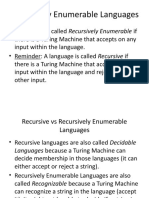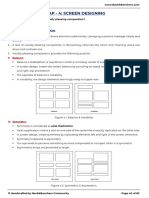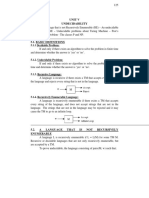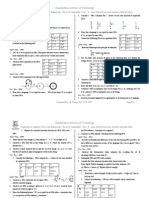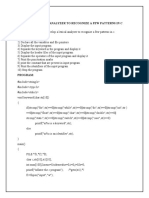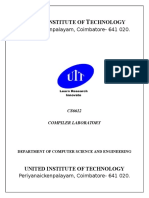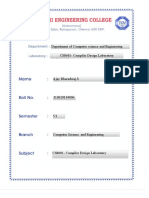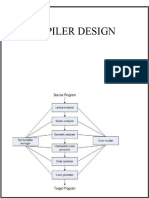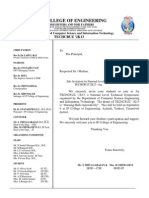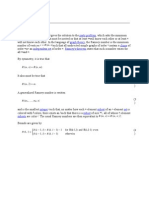100%(4)100% found this document useful (4 votes)
6K views60 pagesCS6612 Compiler Lab Manual
As per Anna university syllabus all exercises are done in this manual.
Uploaded by
sendhil28Copyright
© © All Rights Reserved
We take content rights seriously. If you suspect this is your content, claim it here.
100%(4)100% found this document useful (4 votes)
6K views60 pagesCS6612 Compiler Lab Manual
As per Anna university syllabus all exercises are done in this manual.
Uploaded by
sendhil28Copyright
© © All Rights Reserved
We take content rights seriously. If you suspect this is your content, claim it here.
You are on page 1/ 60
JP COLLEGE OF ENGINEERING ©S6612 / T6612 - COMPILER LABORATORY.
CS6612 / 116612 - COMPILER LABORATORY LTPC
OBJECTIVES: The student should be made to:
Be exposed to compiler writing tools.
Learn to implement the different Phases of compiler
+ Be familiar with control flow and data flow analysis
+ Learn simple optimization techniques
LIST OF EXPERIMENTS:
1. Implementation of Symbol Table
2. Develop a lexical analyzer to recognize a few patterns in C. (Ex. identifiers, constants,
comments, operators ete.)
3. Implementation of Lexical Analyzer using Lex Tool
4. Generate YACC specification for a few syntactic categories. a) Program to recognize a valid
arithmetic expression that usesoperator +, - , * and /. b) Program to recognize a valid variable
which starts with a letterfollowed by any number of letters or digits. d)Implementation of
Calculator using LEX and YACC
5. Convert the BNF rules into Yace form and write code to generate Ab:
6, Implement type checking
7. Implement control flow analysis and Data flow Analysis
8, Implement any one storage allocation strategies(Heap,Stack,Static)
9. Construction of DAG
10. Implement the back end of the compiler which takes the three address code and produces the
8086 assembly language instructions that can be assembled and run using a 8086 assembler. The
target assembly instructions can be simple move, add, sub, jump. Also simple addressing modes
are used.
11. Implementation of Simple Code Optimization Techniques (Constant Folding., etc.)
ct Syntax Tree.
TOTAL: 45 PERIODS
OUTCOMES: At the end of the course, the student should be able to
% Implement the different Phases of compiler using tools
+ Analyze the control flow and data flow of a typical program
% Optimize a given program
“© Generate an assembly language program equivalent to a source language program
LIST OF EQUIPMENT FOR A BATCH OF 30 STUDENTS:
Standalone desktops with C / C++ compiler and Compiler writing tools 30 Nos.
(on
Server with C/C++ compiler and Compiler writing tools supporting 30 terminals or more. LEX
and YACC
N.SENTHIL MURUGAN AP/CSE
JP COLLEGE OF ENGINEERING ©S6612 / T6612 - COMPILER LABORATORY.
Ex. No: 1
SYMBOL TABLE IMPLEMENTATI!
Date
AIM:
To write a C program to implement a symbol table.
ALGORITHM:
1) Start the program.
2). Get the input from the user with the terminating symbol ‘$”.
3) Allocate memory for the variable by dynamic memory allocation function.
4) If the next character of the symbol is an operator then only the memory is allocated,
5) While reading, the input symbol is inserted into symbol table along with its memory address.
6) The steps are repeated till ‘S? is reached.
7) To reach a variable, enter the variable to the searched and symbol table has been checked for
corresponding variable, the variable along with its address is displayed as result.
8) Stop the program.
PROGRAM CODING:
#include
#include
#include
#include
#include
#include
void main()
{
int i=0,4=0,x=0,n,flag=0;
void *p, *add[5];
c ch, srch,b[15],d[15],c;
printf ("Expression terminated by $ : ");
while ((c=getchar())!='$"')
{
blil=c;
itt;
N.SENTHIL MURUGAN AP/CSE
JP COLLEGE OF ENGINEERING ©S6612 / T6612 - COMPILER LABORATORY.
}
n=i-1;
printf ("
i=0;
while (i<=n)
{
printf ("te",b[i]);
itt;
}
printf£("\n Symbol Table\n");
printf ("Symbol\taddr\ttype") ;
while (j<=n)
tl
c=bl5]i
if (isalpha (toascii(c)))
{
iven Expression : ");
if(
{
pemalloc(c) ;
add [x] =p;
dix]=c;
printf ("Sc\tSd\tidentifier",c,p);
t
else
{
ch=b[j+1];
if (ch=="+"| | ch:
i
p=malloc(c);
add[x]=p;
d[x]=c;
printf ("\n%c\t%d\tidentifier\n",c,p);
xtt;
byt
Itt:
t
printf£("\nThe symbol is to be searched");
srch=getch ();
for (i=0; i<=x; i++)
{
N.SENTHIL MURUGAN AP/CSE e-Mail : sendhil28@gmail.com
JP COLLEGE OF ENGINEERING $6612 / 116612 - COMPILER LABORATORY
dti])
print£("\nSymbol Found”);
@address ",add[i]);
print£("\nSymbol Not Found");
getch();
I
OUuTPt
res
Picererares
identifier
identifier
cory emreersereies ory
Sens
a ear)
RESULT:
Thus the above the program is executed and the required output is obtained.
N.SENTHIL MURUGAN AP/CSE
JP COLLEGE OF ENGINEERING ©S6612 / T6612 - COMPILER LABORATORY.
Ex.No :2
| | IMPLEMENTATION OF LEXICAL ANALYSIS IN C
Date: |
aC Program to implement a Lexical analyzer.
ALGORITHM:
1) Start the program.
2) Declare all the variables and file pointers.
3) Display the input program.
4), Separate the keyword in the program and display it.
5) Display the header files of the input program.
6) Separate the operators of the input program and display it.
7) Print the punctuation marks.
8) Print the constant that are present in input program.
9) Print the identifiers of the input program.
10) Stop the program.
PROGRAM CODING:
#include
#include
#include
void keyw(char *p);
int i=0,id=0,kw=0,num=0, o0p=0;
char
keys[32] [10]=("auto", "break", "case", "char", "const", “continu
en, "default",
"do", "double", "else", "enum", "extern", "float", "for", "goto",
"if", "int", "long", "register", "return", "short", "signed",
N.SENTHIL MURUGAN AP/CSE e-Mail : sendi
8@gmail.com
JP COLLEGE OF ENGINEERING ©S6612 / T6612 - COMPILER LABORATORY.
"sizeof", "static", "struct", "switch", "typedef", "union",
"unsigned", "void", "volatile", "while");
main ()
{
char ch, str[25],seps [15
\t\n, 7 0.0) U#\ "<2", oper [J=" 1876 —t==|.<>/2"7
int 4;
char fname [50];
FILE *f1;
//elrser();
printf ("enter file path (drive:\\fold\\ filename) \n") ;
scanf("$s", fname) ;
£1 = fopen(fname,"r");
//£1 = fopen("Input", "0");
if (£1==NULL)
(
goto END;
}
while ( (ch=fgetc(£1))!
{
for (4=0; 4<=14; j++)
OF)
print£("%c is an operator\n",ch);
opt+;
str[i]="\0';
keyw(str);
}
}
for (j=0; j<=14; j++)
{
N.SENTHIL MURUGAN AP/CSE e-Mail : sendhil28@gmail.com
JP COLLEGE OF ENGINEERING ©S6612 / T6612 - COMPILER LABORATORY.
if(i
1)
break;
while (ch
(
print£("%e", ch);
ry
dl
}
printf("&c is a header file\n",ch);
fgetc (£1);
break;
}
if(c
{
do
{
ch=fgetc (£1);
print£("%c",ch) ;
}while (cl
print£("\b is an argument \n");
isl;
break;
}
str[i]="\0';
keyw(str);
N.SENTHIL MURUGAN AP/CSE e- Mai
8@gmail.com
JP COLLEGE OF ENGINEERING ©S6612 / T6612 - COMPILER LABORATORY.
str[i]=ch;
itt;
else
i=0;
)
printf ("Keywords: %d\nIdentifiers: %d\nOperators:
d\nNumbers: %d\n",kw, id, op, num) ;
J/getch ();
END:
printf ("file not found");
}
void keyw(char *p)
i
int k, £lag=0;
for (k=0;k<=31;k++)
t
if (st romp (keys [k] ,p)=-0)
{
printf ("ts is a keyword\n",p);
kwtt;
flag-1;
break;
}
1
if (flag--0)
t
if (isdigit (p[0]))
t
printf ("ts is a number\n",p);
num++7
}
N.SENTHIL MURUGAN AP/CSE e- Mai
JP COLLEGE OF ENGINEERING ©S6612 / T6612 - COMPILER LABORATORY.
else
i
//4£ (p[0] !=13eep[0] !=10)
if (p[0] !="\0")
{
printf ("ts is an identifier\n",p);
idtt;
}
INPUT: (INPUT.
#include
#include
void main()
{
Int a,b,c;
c=atb;
printi(“The sum is %d",¢);
getch();
}
N.SENTHIL MURUGAN AP/CSE e-Mail : sendhil28@gmail.com
JP COLLEGE OF ENGINEERING $6612 / 116612 - COMPILER LABORATORY
OUTPUT
c:\Flex \Windows\EditPlusPortable>a
lenter File path (dive:\fold\filename?
Fates
Htinclude is a header file
Peete ser
an identifier
identifier
identifier
identifier
Pesaas
identifier
iors
operator
identifier
Pers
an operator
an identifier
an operator
an identifier
an identifier
printf is an identifier
The is an identifier
SeCeUMetCitetetry
is an identifier
PU Sa
dé is an identifier
ic is an identifier
lgetch is an identifier
C:\Flex Windows\EditPlusPortable>.
RESULT
Thus the above the program is executed and the required output is obtained.
N.SENTHIL MURUGAN AP/CSE €- Mail: sendhil28@gmail.com
JP COLLEGE OF ENGINEERING ©S6612 / T6612 - COMPILER LABORATORY.
eNOS IMPLEMENTATION OF LEXICAL ANALYSER USING
Date: LEX TOOL
AIM:
To write a lex program to implement the lexical analyzer.
ALGORITHM:
1. Start the program
Open a file file.c in read and include the yylex() tool for input scanning.
3. Define the alphabets and numbers.
4. Print the preprocessor, function, keyword using yytext.lex tool.
5. Print the relational, assignment and all the operator using yytext() tool.
6. Also scan and print where the loop ends and begins.
7. Use yywrap() to enter an error
8. Stop the program.
PROGRAM CODIN
identifier [_a-zA-z] [_a-zA-z0-9]*
ae
#.* (printf("\n%s is a PREPROCESSOR DIRECTIVE", yytext);)
int |
double
N.SENTHIL MURUGAN AP/CSE
JP COLLEGE OF ENGINEERING ©S6612 / T6612 - COMPILER LABORATORY.
float |
char |
while |
for |
do |
Herat
break |
continue |
void |
switch |
case |
long |
struct |
const |
typedef |
return |
else |
goto {print£("\n\t%s is a KEYWORD", yytext);}
"/*" (COMMENT=1;
print£("\n\n\t COMMENT ENDS\n");}
(identifier) \( (if (!COMMENT)
printf£("\n\t %s ) is a FUNCTION \n",yytext);}
\{ (Af ({commENT) print£("\n\t BLOCK BEGINS"); }
\} (AE (1COMMENT) print£("\n\t BLOCK ENDS"); }
(identifier) (\[[0-9]*\])? (if (COMMENT) printf("\n\t %s
IDENTIFIER", yytext) ;)
\".#\" (4 £(!COMMENT) printf£("\n\t %s is a STRING", yytext);}
[0-9]+ {if (!COMMENT) printf("\n\t %s is a NUMBER", yytext);}
N.SENTHIL MURUGAN AP/CSE e-Mail : sendhil28@gmail.com
JP COLLEGE OF ENGINEERING ©S6612 / T6612 - COMPILER LABORATORY.
\) QF)? {4 £({COMMENT) print£("\n\t");ECHO; print£("\n");}
\( ECHO;
= (if (1COMMENT) print£("\n\t%s is an ASSIGNMENT
OPERATOR", yytext);}
\<= |
ve
{if (COMMENT) printf£("\n\t%s is a RELATIONAL
OPERATOR", yytext) ;}
\FI\SI\FI\BI\/ (4£(1COMMENT) print£("\n\t%s is a ARITHMETIC
OPERATOR", yytext) ;}
a
int main(int argc, char **argv)
{
if(arge > 1)
{
FILE *file;
file-fopen(argv[1],"2");
if(!file)
{
printf ("could not open %s\n",argv[1]);
exit (0);
}
yyin=file;
}
yylex();
printf ("\n\n");
return 0;
N.SENTHIL MURUGAN AP/CSE e-Mail : sendhil28@gmail.com
JP COLLEGE OF ENGINEERING
}
int yywrap ()
{
return 0;
}
UT (area.c):
#include
#include
double area_of_circle(double 1);
int main(int arge,char *argv[])
{
iffarge <2)
{
printf("usage: %s radius\n" argv[0]);
{
exit(L);
}
else {
double radi
=atoftargv[ I);
double area=area_of_circle(radius);
©S6612 / T6612 - COMPILER LABORATORY.
printf("Area of circle with radius %f=6f\n" radius,area);
return 0;
N.SENTHIL MURUGAN AP/CSE
e- Mai
8@gmail.com
JP COLLEGE OF ENGINEERING $6612 / 116612 - COMPILER LABORATORY
OUTPUT
RESULT:
Thus the above the program is executed and the required output is obtained.
N.SENTHIL MURUGAN AP/CSE
JP COLLEGE OF ENGINEERING ©S6612 / T6612 - COMPILER LABORATORY.
oe No Tea YACC PROGRAM TO RECOGNIZE A VALID
Date: ARITHMETIC EXPRESSION
AIM:
ALGORITHM:
PROGRAM CODING:
%{ /* validate simple arithmetic expression */
finclude
#include
#include
finclude
#define YYSTYPE double
Bh
token num
left ‘+!
left '*'
Be
st: st expr '\n' (printf ("Valid"); }
ist ‘\n"
\
lerror '\n' {print £ ("INVALID") ;}
expr: num
jexpr '+! expr
lexpr '/' expr
ae
main ()
t
printf(" ENTER AN EXPRESSION TO VALIDATE");
yyparse ();
}
yylex()
if (isdigit (ch) | ch=
{
ungete (ch, stdin) ;
scanf("%1£", &yylval);
return num;
N.SENTHIL MURUGAN AP/CSE e-Mail
:sendhil28@gmail.com
JP COLLEGE OF ENGINEERING ©S6612 / T6612 - COMPILER LABORATORY.
ee
pha (char *s)
eetee ests ein
oureur:
:\Flex Windows\EditPlusPortable>yace -d arithval.y
C:\Flex Windows\EditPlusPortable>ce y.tab.c -I
C:Flex Windows\EditPlusPortable>./a.out
ENTER AN EXPRESSION TO VALIDATES+9
Valid
446
Valid
5
INVALID
RESULT:
Thus the above the program is executed and the required output is obtained
N.SENTHIL MURUGAN AP/CSE e-Mail : sendhil28@gmail.com
JP COLLEGE OF ENGINEERING ©S6612 / T6612 - COMPILER LABORATORY.
Ex. No: 4b
YACC PROGRAM TO RECOGNIZE A VALID VARIABLE
Date:
AIM:
ALGORITHM:
PROGRAM CODING:
&{ /* ¥ prg to recognize valid variable, which starts with a
letter,
followed by any number of letters or digits. */
#include
#include
8h
token let dig
sad: let recld '\n' {print£("accepted\n"); return 0;}
| let '\n' {printf ("accepted\n"); return 0;)
|
lerror {yyerror("rejected\n"};return 0;}
recld: let recld
| dig recid
| let
| dig
8
yylex()
(
char ch;
while ( (ch=getchar (
if (isalpha (ch)
return let;
if(isdigit (ch))
return dig;
return ch;
}
yyerror (char *s
(
printf ("$s",s);
}
N.SENTHIL MURUGAN AP/CSE e- Mai
8@gmail.com
JP COLLEGE OF ENGINEERING ©S6612 / T6612 - COMPILER LABORATORY.
main()
{
printf ("ENTER A variable
yyparse ();
}
Output:
CaFlex Windows\EditPlusPortable>yace -d vvar.y
CAFlex Windows\EditPlusPortable>ce y.tab.c I
CAFlex Windows\EditPlusPortable> /a.out
ENTER A variable : a45
accepted
CAFlex Windows\EditPlusPortable> /a.out
ENTER A variable : Se
syntax errorrejected
CAFlex Windows\EditPlusPortable> /a.out
ENTER A variable : ab
accepted
RESULT:
Thus the above the program is executed and the required output is obtained.
N.SENTHIL MURUGAN AP/CSE e- Mai
8@gmail.com
JP COLLEGE OF ENGINEERING ©S6612 / T6612 - COMPILER LABORATORY.
Boles IMPLEMENTATION OF CALCULATION USING LEX
arcatsatii |
DEEEE AND YACC
|
AIM:
To write a program to implement calculator using lex and yace.
ALGORITHM:
1. Start the program,
Perform the calculation using both the lex and yace.
3. In the lex tool, ifthe given expression contains numbers and letters then they are
displayed
4, Inthe same way, the digit
tool.
letters and uminus are identified and displayed using yace
5. The calculation is performed and the result is displayed.
6. Stop the program,
PROGRAM CODING:
USING LEX TOO!
aL
include
finclude "y.tab.h"
int ¢;
extern int yylval;
a}
(a-z] {
c = yytext [0];
yyly. cn tat;
return (LETTER) ;
}
[0-3] {
c = yytext [0];
yylval = c - '0';
N.SENTHIL MURUGAN AP/CSE
com
JP COLLEGE OF ENGINEERING ©S6612 / T6612 - COMPILER LABORATORY.
return (DIGIT) ;
}
[*a-z0-9\b] {
c = yytext [0];
return (c);
}
8%
USING YACC TOOL:
&(
#include
int regs[26];
int base;
8}
astart list
&token DIGIT LETTER
Sleft ‘|!
left 's!
fleft ‘+!
Bleft tt 1st tye
left UMINUS /*supplies precedence for unary minus */
ae /* beginning of rules section */
list: /*empty */
I
list stat '\n'
I
list error '\n'
{
yyerrok;
}
stat: expr
{
printf ("#d\n",$1);
}
I
LETTER
{
regs[$1]
expr
$3;
}
{
expr: (expect)
$$ = $2;
}
I
expr '*' expr
N.SENTHIL MURUGAN AP/CSE e- Mai
8@gmail.com
JP COLLEGE OF ENGINEERING
{
$$
}
I!
expr
{
$$
}
I
expr
{
$$
}
I
expr
{
$$
}
I!
expr
{
$$
}
l
expr
{
$$
)
l
expr
{
$$
}
I
fl
imaS1 1") $05
'/) expr
= $1 / $3;
" expr
= $1 % $3;
"+! expr
Sas licnieds
* expr
= $1 - $3;
"Gg! expr
= $1 & $3;
expr
= $1 | $3;
' expr %prec UMINUS
SB iae2r)
}
Il
LETTER
{
$$ = regs[$1];
)
I
number
number: DIGIT
N.SENTHIL MURUGAN AP/CSE
©S6612 / T6612 - COMPILER LABORATORY.
e- Mai
JP COLLEGE OF ENGINEERING $6612 / 116612 - COMPILER LABORATORY
SPST
RESULT:
Thus the above the program is executed and the required output is obtained,
N.SENTHIL MURUGAN AP/CSE
JP COLLEGE OF ENGINEERING ©S6612 / T6612 - COMPILER LABORATORY.
Ex. No: 5 Convert the BNF rules into Yacc form and write
code to generate Abstract Syntax Tre
AIM:
ALGORITHM:
PROGRAM CODIN
LEX
af
#include"y.tab.h"
#include
#include
int LineNo=1;
8h
identifier [a-zA-zZ] [_a-zA-z0-9]*
number [0-9]+1 ([0-9]1*\.[0-9]+)
Be
main\(\) return MAIN;
if return IF;
else return ELSE;
while return WHILE
float return TYPE;
{identifier} {strepy (yylval.var, yytext)
return VAR;
(number) {strepy (yylval.var, yytext)
return NUM;)
\<
\>
\>
N.SENTHIL MURUGAN AP/CSE
JP COLLEGE OF ENGINEERING
{strepy (yylval.var, yytext) ;
return RELOP;}
(MANSIANA
\n LineNot++;
return yytext [0];
BB
int yywrap() (
return 1;
}
YAce
BL
#include
#include
#include
void push (int);
©S6612 / T6612 - COMPILER LABORATORY.
void AddQuadruple (char *,char *,char *,char *);
struct quad
(
char op[5];
char argl(10];
char arg2[10];
char result [10];
QUAD [3017
struct stack
t
int items[100];
int top;
bstky
int Index=0,tIndex=0, StNo, Ind, tInd;
extern int LineNo;
Sh
N.SENTHIL MURUGAN AP/CSE
e- Mai
sendhil28@gmail.com
JP COLLEGE OF ENGINEERING ©S6612 / T6612 - COMPILER LABORATORY.
union
{
char var[10];
}
%token NUM VAR RELOP
token MAIN IF ELSE WHILE TYPE
&type EXPR ASSIGNMENT CONDITION IFST ELSEST WHILELOOP
Bleft '-' "+
Sleft #1 1/!
88
PROGRAM : MAIN BLOCK
BLOCK: '{' CODE '}!
CODE: BLOCK
| STATEMENT CODE
| STATEMENT
STATEMENT: DESCT ';
| ASSIGNMENT ';'
| ConpsT
| WHILEST
DESCT: TYPE VARLIST
VARLIST: VAR ',' VARLIST
| VAR
ASSIGNMENT: VAR '=' EXPR(
strcpy (QUAD[ Index] .op,
st repy (QUAD [Index] .argl, $3);
strcpy (QUAD[Index] .arg2,"");
N.SENTHIL MURUGAN AP/CSE
sendhil28@gmail.com
JP COLLEGE OF ENGINEERING ©S6612 / T6612 - COMPILER LABORATORY.
strepy (QUAD [Index] result, $1);
st repy ($$, QUAD[Index++] . result);
}
EXPR: EXPR '+' EXPR {AddQuadruple("+",$1,$3,$$);}
| EXPR '-' EXPR {AddQuadruple("-",$1,$3,$$);}
| EXPR '*! EXPR (AddQuadruple("*",$1,$3,$$) i}
| BXPR '/* EXPR (AddQuadruple("/", $1, $3,$$)7}
‘-' EXPR {AddQuadruple ("UMIN", $2,"",$$)
EXPR (stropy ($$, $2);)
| VAR
| num
CONDST: IFST(
Ind=pop ()
sprintf (QUAD[Ind] .result, "$d", Index) ;
Ind=pop ()
sprintf (QUAD[Ind] .result, "%d", Index) ;
I
| IFST ELSEST
IFST: IF '(' CONDITION ')' {
my
st repy (QUAD [Index] .argl, $3);
strepy (QUAD [Index] .op,
st repy (QUAD [Index] .arg2, "FALSE") ;
st rcpy (QUAD[Index] .result,"-1");
push (Index) ;
Indext+;
}
BLOCK {
st repy (QUAD [Index] .op, "GOTO") ;
strcpy (QUAD[Index] .argl,"");
N.SENTHIL MURUGAN AP/CSE e-Mail : sendhil28@gmail.com
JP COLLEGE OF ENGINEERING ©S6612 / T6612 - COMPILER LABORATORY.
st rcpy (QUAD[Index] .arg2,"");
st repy (QUAD [Index] .result,"-1");
push (Index) ;
Index++;
he
ELSEST: ELSE(
tInd=pop ();
Ind=pop () +
push (tind);
sprintf (QUAD[Ind] .result, "$d", Index) ;
}
BLOCK (
Ind=pop ()
sprintf (QUAD[Ind] .result, "$d", Index) ;
hi
CONDITION: VAR RELOP VAR (AddQuadruple ($2, $1,$3, $$);
StNo=Index-1;
}
| VAR
| NUM
WHILEST: WHILELOOP{
Ind=pop () +
sprintf (QUAD[Ind] .result, "*d", StNo) ;
Ind=pop () +
sprintf (QUAD[Ind] .result, "%a", Index) ;
}
WHILELOOP: WHILE '
CONDITION ')' {
strcpy (QUAD[ Index] .op,
st repy (QUAD [Index] .argl, $3);
st rcpy (QUAD[Index] .arg2, "FALSE") ;
N.SENTHIL MURUGAN AP/CSE e-Mail : sendhil28@gmail.com
JP COLLEGE OF ENGINEERING ©S6612 / T6612 - COMPILER LABORATORY.
strepy (QUAD [Index] .result, "-1");
push (Index) ;
Index++;
}
BLOCK {
strepy (QUAD [Index] .op, "GOTO") ;
strepy (QUAD [Index] .argl,"");
strepy (QUAD [Index] .arg2,"") ;
strepy (QUAD [Index] .result,"-1");
push (Index) ;
Index++;
b
cy
extern FILE *yyin;
int main(int arge,char *argv[])
(
FILE “fp;
int i;
if (arge>1)
t
fp=fopen (argv(1],"r");
if (!£p)
r
print£("\n File not found");
exit (0);
}
yyin-fp;
}
yyparse();
N.SENTHIL MURUGAN AP/CSE e- Mai
JP COLLEGE OF ENGINEERING ©S6612 / T6612 - COMPILER LABORATORY.
print £("\n\n\t\t——
\n\t\t
Pos Operator Argl Arg2_ Result \n\t\t-- i
he
for (i=; i
#include
#include
#include
#include
char* type(char{], int);
void main()
c
char a[10],b[10],mess[20],mess1[20];
int i,1;
elrser();
print£( "\n\n int a,b;\n\n int c=atb\n")
printf( "\n\n Enter a value for a\n")
scanf("#s", a);
l=strlen(a);
printf(™ \n a is i");
stropy (mess, type (a,1)) 7
print£("%s",mess);
printf( "\n\n Enter a value for b\n\n")
scanf("&s",b);
l=strlen(b);
printf(" \n b is :")
strepy (messi, type (by 1));
N.SENTHIL MURUGAN AP/CSE e- Mai
8@gmail.com
JP COLLEGE OF ENGINEERING ©S6612 / T6612 - COMPILER LABORATORY.
printf ("%s",mess1) ;
if(stromp(mess, "int"
t
printf£("\n\n No Type Error");
}
else
t
printf("\n\n Type Error");
}
getch();
}
char* type(char x{],int m)
t
int i;
Ogestrcmp (messi, "int")
char mes [20];
for (1-0; i
#include
#include
#include
struct Listnode
t
char data[50];
int leader, block, u_goto, c_goto;
struct Listnode *next;
char label[10],target [10];
}*temp, *cur, *first=-NULL, *last=NULL, *curl;
FILE *fpry
void createnode (char code[50])
(
temp=(struct Listnode *)malloc (sizeof (struct
Listnode) );
strcpy (temp->data, code) ;
strepy (temp->label, '\0");
strepy (temp->target, '\0");
temp->leader=0;
temp->block=0;
temp->u_goto=0;
N.SENTHIL MURUGAN AP/CSE e- Mai
8@gmail.com
JP COLLEGE OF ENGINEERING ©S6612 / T6612 - COMPILER LABORATORY.
temp->c_goto=0;
temp->next=NULL;
if (first:
{
first=temp;
ULL)
last=temp;
)
else
{
last~>next=temp;
last=temp;
)
}
void printlist ()
i
cur=first;
printf ("\nMIR code is \n\n");
while (cur!=NULL)
{
print£ ("\ncode:%s",cur->data) ;
printf ("\nleader:$d\t", cur->leader) ;
print ("block:%d\t", cur->block) ;
print£ ("u_goto:%d\t", cur->u_goto) ;
print£ ("c_goto:%d\t", cur->c_goto) ;
printf ("label:%s\t", cur->label) ;
printé ("target:%s\n", cur->target);
cur=cur->next;
}
N.SENTHIL MURUGAN AP/CSE e-Mail : sendhil28@gmail.com
JP COLLEGE OF ENGINEERING ©S6612 / T6612 - COMPILER LABORATORY.
void main()
{
char codeline[501;
char c,dup[50],target [10];
char *substring, *token;
int i=0,block,block1;
int 4=0;
fpr= fopen("input .txt","r");
clrser();
while ((
{
if(c!="\n')
{
jet c (fpr) ) !=EOF)
codeline[i]=c;
itt;
else
codeline[i]='\0';
createnode (codeline);
i=0;
}
,
//create last node
codeline[i]="\0';
createnode (codeline);
fclose (fpr);
uw printlist ();
// find out leaders,conditional stmts
cur=first;
N.SENTHIL MURUGAN AP/CSE e- Mai
sendhil28@gmail.com
JP COLLEGE OF ENGINEERING ©S6612 / T6612 - COMPILER LABORATORY.
cur->leader=1;
while (cur!=NULL)
{
substring=strstr ((cur->data) ,"if");
if ((strstr ((cur->data), "goto")) !=NULL)
{
cur->u_goto=1;
(cur->next) ->leade:
}
)
else
{
cur->c_goto=1;
(cur->next)->leader=1;
,
substring-strstr ((cur->data) ,":")i
if (substring! =NULL)
(
cur->leader=1;
)
substring=strstr ((cur->data) ,"call");
if (substring!=NULL)
{
cur->leader=1;
)
if (strstr (cur->data, "return") !=NULL)
{
cur->leader=1;
(cur->next) ->leader=1;
,
N.SENTHIL MURUGAN AP/CSE e-Mail : sendhil28@gmail.com
JP COLLEGE OF ENGINEERING ©S6612 / T6612 - COMPILER LABORATORY.
cur=cur->next;
)
//to find labels and targets
cur-first;
while (cur!
(
4£((cur->u_goto:
(
subst ring-strstr (cur->data,
ULL
ULL)
1) 11 (cur->e_got:
eT
if (substring!
{
toke!
trstr (substring, "L" );
if (token!=NULL)
strepy (cur->target, token)
}
else
{
subst ring-strstr(cur->data, "L");
if (substring! =NULL
st repy (cur->target, substring) ;
}
)
if (strstr (cur—>data,":"
{
strepy (dup, cur->data) ;
token=strtok (dup, ":");
// printé ("\ntokel
ULL)
strepy (cur->label, token) ;
)
3", token);
if (token
cur=cur->next;
N.SENTHIL MURUGAN AP/CSE
JP COLLEGE OF ENGINEERING
MW printlist ();
//to identify blocks
cur=first;
while (cu
{
cur=cur->next;
NULL)
if ((cur->leader)
(
itt
cur->block=3;
}
else
cur->block=3;
}
// printlist (0;
// print basic blocks
printf("\n\n......Basic Blocks
cur=first;
5-0;
print£("\nBlock $d:",4)¢
while (cur!=NULL)
{
if ((cur->block)
ce
print£("%s",cur->data);
printf ("\n\t");
cur=cur->next;
N.SENTHIL MURUGAN AP/CSE
©S6612 / T6612 - COMPILER LABORATORY.
s\n");
e- Mai
JP COLLEGE OF ENGINEERING ©S6612 / T6612 - COMPILER LABORATORY.
else
{
Ht;
printf ("\nBlock %d:", 3);
}
}
//to output the control flow from each block
poiineen (Ae cue Control Flow....... \a\n");
cur-first;
i-0;
while (cur!=NULL)
i
if ({cur->block) !
i
block=cur->block;
cur->next) ->block)
if (cur->u_goto
{
strepy (target, cur—>target) ;
curi=first;
while (curl !=NULL,
{
if (stomp (curl->label, target
{
0)
blockl=curl->block;
Print £("\t\tBlock%d-
>Blockd\n", block, block1) ;
)
curl=curl->next;
}
N.SENTHIL MURUGAN AP/CSE e- Mai
sendhil28@gmail.com
JP COLLEGE OF ENGINEERING ©S6612 / T6612 - COMPILER LABORATORY.
else if (cur->c_got:
{
strepy (target, cur->target) ;
1)
curl=first;
while (curl !=NULL)
{
if (strcmp (curl->label, target
(
0)
block1
ur1->block;
printé ("\t\tBlock$d---TRUE--->Block$d---FALSE-—
->Block#d\n", block, block1, (block+1))
)
curl=curl->next;
}
}
else if(strstr(cur->data, "return"
{
print£("\t\tBlock’d-
>Block%d\n", block, (block+1));
}
else
printf ("\t\tBlocktd--
->NULL\n", block) ;
cur=cur->next;
}
cur=last;
block= cur->block;
printé("\t\tBlock%d--
-->NULL", block) ;
getch ();
N.SENTHIL MURUGAN AP/CSE e-Mail : sendhil28@gmail.com
JP COLLEGE OF ENGINEERING
INPUT (input.txt)
oer
Poteet
ara
SSAA
orn)
SAA
brtaet} sR
N.SENTHIL MURUGAN AP/CSE
$6612 / 116612 - COMPILER LABORATORY
e- Mail
sendhil28@gmail.com
JP COLLEGE OF ENGINEERING ©S6612 / T6612 - COMPILER LABORATORY.
IMPLEMENTATION OF STORAGE ALLOCATION
STRATEGY
AIM:
ALGORITHM:
PROGRAM CODIN
#include"stdio.h"
#include"conio.h"
#include"stdlib.h"
define TRUE 1
define FALSE 0
typedef struct Heap
{
int data;
struct Heap ‘next;
}node;
node *create();
void main()
{
/*local declarations*/
int choice, val;
char ans;
node *head;
void display (node *);
node *search (node *, int);
node *insert (node *);
void dele(node **);
head=NULL;
do
{
elrser();
printf£("\n Program to perform various operations on heap
using dynamic memory management”);
printf (*\nl.Create”):
printf ("\n2.Display”
printf ("\n3.Insert an element in a list”);
printf (“\n4.Delete an element from list”);
printf ("\n5.Quit”);
printf ("\n Enter Your Choice (1-5)");
scanf (“d, &choice”);
switch (choice:
{
N.SENTHIL MURUGAN AP/CSE e- Mai
8@gmail.com
JP COLLEGE OF ENGINEERING ©S6612 / T6612 - COMPILER LABORATORY.
case 1:head=create();
break;
case 2:display (head);
break;
case 3:head=insert (head) ;
break;
case 4idele(&head);
break;
case 5:exit (0);
default :clrser();
printf (“Invalid Choice,Try again”);
getch ();
i
}while (choice
}
/*The create function creates a list of allocated node
*Input :None
*Output :Retyurns a pointer to head of list
*Parameter Passing Methopd:Node
e/
node *create()
{
node *temp, *new,* head;
int val, flag;
char ans="y’
node *get_node();
temp=NULL;
flag=TRUE;
/*flag to indicate whether a new node is created for the
first time or not*/
do
{
printf("\n Enter the Element”);
scanf ("$d”, &val) ;
/*allocate new node*/
new =get_node();
printf("\n Memory is not allocated”);
new-> data=val;
if (flag--TRUE)/* Executed only for the first time*/
{
head:
new;
ead; /*head is the first node in the heap*/
N.SENTHIL MURUGAN AP/CSE ¢- Mail : sendhil28@gmail.com
JP COLLEGE OF ENGINEERING ©S6612 / T6612 - COMPILER LABORATORY.
}
else
{
/*temp keeps track of the most recently created node*/
temp->next=new;
temp=new;
}
print£(\nDo you want to enter more elements? (y/n)”
ans=getch ()7
}while (ans
ye
printf("\nThe list is created”);
getch);
elrser();
return head;
I
node *get_node()
{
node *temp;
temp=(node*) malloc (sizeof (node) );
//asing the mem. Allocation function
temp->next =NUL!
return temp;
I
void display (node*head)
t
node *temp;
temp=head;
if (temp= =NULL)
(
printf£("\n The list is empty\n”);
getch();
elrser();
return;
}
while (temp!
(
printf (“td->”,temp-> data);
temp=temp->next;
}
print (“NULL”);
getch();
elrser();
}
node *search(node *head, int key)
NULL)
N.SENTHIL MURUGAN AP/CSE sendhil28@gmail.com
JP COLLEGE OF ENGINEERING ©S6612 / T6612 - COMPILER LABORATORY.
t
node*temp;
int found;
temp=head;
if (temp:
t
printf (“The linked list is empty\n”);
getch();
elrser();
return NULL;
}
ull)
found=FALS
While (temp
{
if (temp->data != key)
temp = temp->next;
else
found = True;
}
NULL && foun:
if (found
(
print£("\n The Elements is present in the list”\n);
getch();
return tem
}
TRUE)
else
printf("\n The Element is not present in the list\n");
getch ();
return NULL;
}
node *insert (node *head)
t
int choice;
node *insert_head (node*);
void insert_after (node*);
void insert_last (node*) ;
printf("\n"1.Insert a node as a head node”);
printf("\n"l.Insert a node as a last node”);
printf("\n"l.Insert a node as at the intermediate position
in the list ”);
printf("\n”l.Enter your choice for insertion of node ”);
scanf (“#d”, échoice) 7
switch (choice)
(
case 1:head = insert_head (head);
N.SENTHIL MURUGAN AP/CSE ¢- Mail : sendhil28@gmail.com
JP COLLEGE OF ENGINEERING
break;
case2:insert_last (head) ;
break;
case2:insert_after (head);
break;
}
return head;
}
/*Insertion of node at first position*/
node *insert_head (node*head)
(
node *New, *temp;
New = get_node();
printf ("\n Enter the element which you
scanf (“%d”, &New->data) ;
if(head == NULL)
head = New;
else
i
temp=head;
New->next = temp;
head= New;
}
return hea
}
/*Insertion of node at last position*/
void insert_last (node *head)
(
node *New, *temp;
New = get_node ();
printf ("\n Enter the element which you
scanf (“#d”, 6New->data) ;
if(head == NULL)
t
head = New;
}
else
i
temp-head;
while (temp->next
temp=temp->next;
temp->next
New->next=NULL;
N.SENTHIL MURUGAN AP/CSE
©S6612 / T6612 - COMPILER LABORATORY.
want to insert ”);
want to insert “);
e-Mail : sendhil28@gmail.com
JP COLLEGE OF ENGINEERING ©S6612 / T6612 - COMPILER LABORATORY.
}
}
/*Insertion of node at intermediate position*/
void insert_after(node *head)
{
int key;
node *New, *temp;
New = get_node();
print£("Enter the element after which you want to insert
De
scanf (“#d”, 6key) ;
temp=head;
do
{
if (temp->data
{
printf ("Enter element which you want to insert ”);
scanf (“%d", éNew->data) ;
New->next=temp->next;
temp->next=New;
return;
ey)
node *get_prev(node *head, int val)
{
node*temp. *prev;
int flag;
temp = hea
if (temp == NULL)
return NULL;
flag = FALSE;
prev = NULL;
while (temp
(
if (temp->data!
(
prev = temp;
ULL && !flag)
al)
temp = temp->next;
t
else
flag = TRUE;
}
if(flag) /*if Flag is true*/
return prev;
N.SENTHIL MURUGAN AP/CSE ¢- Mail : sendhil28@gmail.com
JP COLLEGE OF ENGINEERING ©S6612 / T6612 - COMPILER LABORATORY.
else
return NULL;
}
void dele(node **head)
{
int key;
node *New, *temp;
temp=*head;
if (temp:
(
printf ("\n The list is empty\n ”);
getch ();
elrser();
return;
}
elrser();
print£("\nENTER the Element you want to delete
scanf ("td".&key);
temp= search (*head, key) ;
if (temp (ULL)
(
prev = get_prev(*head, key) ;
if (prev != NULL)
(
prev ->next = temp-> next;
free (temp);
}
else
(
*head = temp->next;
free(temp); // using the mem. Dellocation function
}
printf (“\n”The Element is deleted\n”);
getch();
elrscr()7
}
NULL)
ouTPUT:
Program to perform various operations on heap using Dynamic memory management.
1. Create
2. Display
3. Insert an element in a list
4, Delete an element from list 5. Quit
N.SENTHIL MURUGAN AP/CSE e- Mai 8@gmail.com
JP COLLEGE OF ENGINEERING ©S6612 / T6612 - COMPILER LABORATORY.
Enter your choice(1-5) 1
Enter the element: 10
Do you want to enter more elements? (y/n)y
Enter the element:20
Do you want to enter more elements?(y/n)y
Enter the element:30
Do you want to enter more elements?(y/n)n
The List is created
Program to perform various operations on Heap using Dynamic memory management.
1. Create
2. Display
3. Insert an element in a list
4, Delete an element from list
5. Quit
Enter your choice(1-5) 4
Enter the element you want to delete: 20
The element is present in the list
The element is deleted
Program to perform various operations on Heap using Dynamic memory management.
1. Create
2. Display
3. Insert an element in a list
4, Delete an element from list
5. Quit
Enter your choice(1-5) 2
10-> 30-> NULL
RESULT:
Thus the above the program is executed and the required output is obtained
N.SENTHIL MURUGAN AP/CSE
sendhil28@gmail.com
JP COLLEGE OF ENGINEERING ©S6612 / T6612 - COMPILER LABORATORY.
Ex. No: 9
CONSTRUCTION OF DAG
AIM:
ALGORITHM:
PROGRAM.
DI
#include
#define N 8
typedef struct node node;
struct node
{
int count;
node *next;
ye
node graph(N];
void buildGraph( int a[](2], int edges )
{
int i;
for( i-0; icount = afil[ll;
ptr->next = graph{ afi][0] ].next;
graph[ a(i][0] ].next = ptr;
graph[ a[i][1] ].count++;
void printGraph()
{
ancien
N.SENTHIL MURUGAN AP/CSE e-Mail : sendhil28@gmail.com
JP COLLEGE OF ENGINEERING ©S6612 / T6612 - COMPILER LABORATORY.
node *ptr;
for( i=0; inext
)
print£( "$a", ptr->count );
printf( "\n" );
t
}
void main()
{
int a[8](2],i,37
clrscr();
print£("\n\nEnter the edges b/w nodes \n");
for (i=0;1<8; i++)
{
for (3=0; 3<2; j++)
{
scanf ("d", &a[i] (41);
t
I
buildGraph( a, 8 );
print£("\nThe DAG for (atb)*c+((atb)+e) : \n\n");
printGraph ();
getch();
N.SENTHIL MURUGAN AP/CSE e-Mail : sendhil28@gmail.com
JP COLLEGE OF ENGINEERING
OUTPUT
$6612 / 116612 - COMPILER LABORATORY
Poe ETC Se ekcee Serene
Posse ay
Pevnvesre ety
cess)
eeeriresee ery
pete oy
r
6
N.SENTHIL MURUGAN AP/CSE
ft
Fl
FI
EB
e- Mail : sendhil28@gmail.com
JP COLLEGE OF ENGINEERING ©S6612 / T6612 - COMPILER LABORATORY.
Ex. No: 10
IMPLEMENTATION OF BACK END OF COMPILER
Date:
AIM:
To write a C program to implement the back end of the compiler.
ALGORITHM:
1) Start the program.
2) Get the three variables from statements and stored in the text file k.txt
3) Compile the program and give the path of the source file.
4) Execute the program.
5) Target code for the given statement was produced.
6) Stop the program.
PROGRAM CODING:
#include
#include
#include
#include
void main() {
int 1-2, j-0,k=2, kL
char ip[101,kk(101;
FILE *£p;
printf("\nEnter the filename of the intermediate code");
scanf("s", ek) ;
fp=fopen (kk, "r");
if (£p==NULL) {
print£("\nError in Opening the file");
geteh();
}
while (!£eof (fp) ) {
fscanf (fp, "$s\n", ip);
printé("\t\t%s\n", ip);
}
rewind (£p);
printé ("\n-
printé ("
printf ("\n-
tatement \t target code\n");
N.SENTHIL MURUGAN AP/CSE e-Mail : sendi
8@gmail.com
JP COLLEGE OF ENGINEERING $6612 / 116612 - COMPILER LABORATORY
Red\n\t", iplitk], i);
nt €("\E\ESUB ");
if (slower (ip[il))
print£("%c,R&d\n\n", ip[itk1], 5) 7
print
iplil, iplit
printé("\n
getch();
ee selteeey
OUTPUT
ee ee eee
one
Esra)
RESULT: Thus the above the program is executed and the required output is obtained
N.SENTHIL MURUGAN AP/CSE sendhil28@ gmail.com
JP COLLEGE OF ENGINEERING ©S6612 / T6612 - COMPILER LABORATORY.
Ex. No: 11
IMPLEMENTATION OF CODE OPTIMIZATION TECHNIQUES
To write a program for implementation of Code Optimization Technique in C.
PROGRAM:
#include
#include
#include
#include
#include
struct ConstFold
(
char new_str[10];
char str[10];
fopt_Data[20];
void ReadInput (char Buffer[],FILE *Out_file);
int Gen_token(char str{],char Tokens[][10]);
int New_Index=0;
int main()
t
FILE *In_file, *Out_file;
char Buffer(100],ch;
int
In_file
Out_file
while (1)
{
ch = fgetc(In_file);
i=0;
while (1)
t
if(ch
break;
Buffer[i++]=ch;
ch = fgete(In_file);
fopen("code.txt","r") 7
fopen ("output txt", "w");
ou)
if(ch == EOF)
break;
}//End while
if(ch
break;
N.SENTHIL MURUGAN AP/CSE
8@gmail.com
JP COLLEGE OF ENGINEERING ©S6612 / T6612 - COMPILER LABORATORY.
Buffer[il='\0';
ReadInput (Buffer, Out_file);//writing to the output file
}//End while
return 0;
}//End main
void ReadInput (char Buffer[],FILE *Out_file’
t
char temp[100], Token{10] [10];
int n,i, 3, flag=0;
strepy (temp, Buffer) ;
n= Gen_token (temp, Token) ;
for (i=0; isn; itt)
t
if(!stromp (Token[i],"="))
t
if (isdigit (Token[i+1] [0]) | |Token[it1] [0
t
/*L£ yes then saving that number and its variable
In the Opt_Data array*/
flag=1;
strepy (opt_Data [New_Index] .new_str, Token [i-1]);
strcpy (opt_Data[New_Index++] .str, Token [i+1]);
t//End if
}//End if
}//End for
if(!flag)
t
for (i=0; i
You might also like
- Write C Programs To Illustrate The Following IPC Mechanisms: A) PipesNo ratings yetWrite C Programs To Illustrate The Following IPC Mechanisms: A) Pipes6 pages
- CD3291 Data Structurres and Algorithm Lab ManualNo ratings yetCD3291 Data Structurres and Algorithm Lab Manual84 pages
- Chap - 4: Screen Designing: Visually Pleasing CompositionNo ratings yetChap - 4: Screen Designing: Visually Pleasing Composition23 pages
- Unit V Undecidability: 5.1.1 Decidable ProblemNo ratings yetUnit V Undecidability: 5.1.1 Decidable Problem23 pages
- Al3411 Artificial Intelligence and Machine Learning Laboratory L T P CNo ratings yetAl3411 Artificial Intelligence and Machine Learning Laboratory L T P C11 pages
- CSE 6th Semester - Web Application Security - CCS374 - Question Bank and Important 2 Marks Questions With AnswerNo ratings yetCSE 6th Semester - Web Application Security - CCS374 - Question Bank and Important 2 Marks Questions With Answer22 pages
- Theory of Computation - Part - B - Anna University Questions100% (1)Theory of Computation - Part - B - Anna University Questions15 pages
- Ex - No:2 Develop A Lexical Analyzer To Recognize A Few Patterns in C Aim: AlgorithmNo ratings yetEx - No:2 Develop A Lexical Analyzer To Recognize A Few Patterns in C Aim: Algorithm7 pages
- CD Expt 3 Implementation of A Lexical Analyzer Using Lex ToolNo ratings yetCD Expt 3 Implementation of A Lexical Analyzer Using Lex Tool6 pages
- 24-Module 4 - Variants of Syntax Trees - Three Address Code-10!09!2024100% (1)24-Module 4 - Variants of Syntax Trees - Three Address Code-10!09!202444 pages
- Theory of Computation - CS3452 - Question Bank and Important 2 Marks Questions With AnswerNo ratings yetTheory of Computation - CS3452 - Question Bank and Important 2 Marks Questions With Answer45 pages
- CS3351-Dpco 2 Mark Answers (All Units,)No ratings yetCS3351-Dpco 2 Mark Answers (All Units,)16 pages
- Discrete Mathematical Structures 15CS36: Course Objectives: This Course Will Enable Students ToNo ratings yetDiscrete Mathematical Structures 15CS36: Course Objectives: This Course Will Enable Students To53 pages
- Oops Through Java Lab Manual - (R22) JntuhNo ratings yetOops Through Java Lab Manual - (R22) Jntuh28 pages
- Ccs341 DW Lab Manual Chumma Chumma Practical NotesNo ratings yetCcs341 DW Lab Manual Chumma Chumma Practical Notes89 pages
- Internal Assessment Test - II IT2032-Software TestingNo ratings yetInternal Assessment Test - II IT2032-Software Testing1 page
- Party Problem Graph Theory Clique Independent Set Ramsey's TheoremNo ratings yetParty Problem Graph Theory Clique Independent Set Ramsey's Theorem2 pages





